I have been to a number of places in India. But Sikkim is a land that I instantly fell in love with. The landscape, the stupas with their gongs, the faith of the Bhutias and Nepali community – it is easy to slip into being spiritual in this place. There were many firsts I encountered here. The blooming rhododendrons in the month of May, hot springs, snow at Zero Point, high altitude sickness at 17,000 feet, the magic of prayer wheels, the warmth of Angeti. Here are a few glimpses of the state.
A glimpse of Sikkim
Sikkim is a bountiful land. In just 7,096 square km, nature has packed the best of peaks, glaciers and waterfalls. Situated in the Eastern Himalayas, the state shares its borders with China, Nepal and Bhutan. There are mighty peaks like Khangchendzonga, Pandim, Tibetan Plateau to the north and Singalia range to the west. The entry to this state is through south Sikkim.The state with a population of 6.1 lakhs as per 2011 Census, has four districts – North, South, East and West, and nine subdivi- sions. Ethnic communities like Lepchas, Shimbus, Bhutias and Nepalese populate this place. The Lepchas are believed to be the original inhabitants of this place, who arrived from a land east of River Teesta. The Bhutias who came to the land around the 17th Century, are basically Tibetans. The Nepalese arrived late, yet today they constitute 70 percent of the population.
The altitude of the place varies drastically from sea-level to as high as 28,208 feet. Thus it supports diverse climate zones like subtropical, humid, semi-temperate, temperate, tundra, etc.
Economy of Sikkim
Sikkim is predominantly an agro-based economy. The harsh terrain does not encourage mining industries or hydroelectric stations. The result – household industries and cottage industries are the major types of industries thriving here. Knitting, carpets, bamboo, basketry, spices, noodles, jams, and fruit preservation are some of the activities that the locals indulge in. The state has a single tea factory – the Temi Tea Estate that serves two varieties of tea – the Orange Pekue and Orthodox. The processing happens at the plant itself. The site is worth a visit, especially in September, when cherry blossoms dot the estate.
Exploring Sikkim
Sikkim is divided into four districts, North, South, East and West. Gangtok in the East district serves as the ideal base to start the Sikkim exploration. Located at 5,480 feet, it has the ideal climate, great food options, funky bazaars, and friendly locals. Gangtok is well connected by roads to various places too. Buses and taxis are available from Gangtok to Siliguri, Darjeeling, Kalimpong etc.
Visiting Gangtok
There are numerous places to visit in Gangtok. Monasteries, stupa, viewpoints, waterfalls, and exhibitions are some of the common attractions. You can spend a whole day touring these sites or customise for a 3 point, 5 point, 7 or 10 point tour. The point is an indicator of the number of places that you can visit in the given tour. Here are a few attractions worth checking out.
The Rumtek Monastery
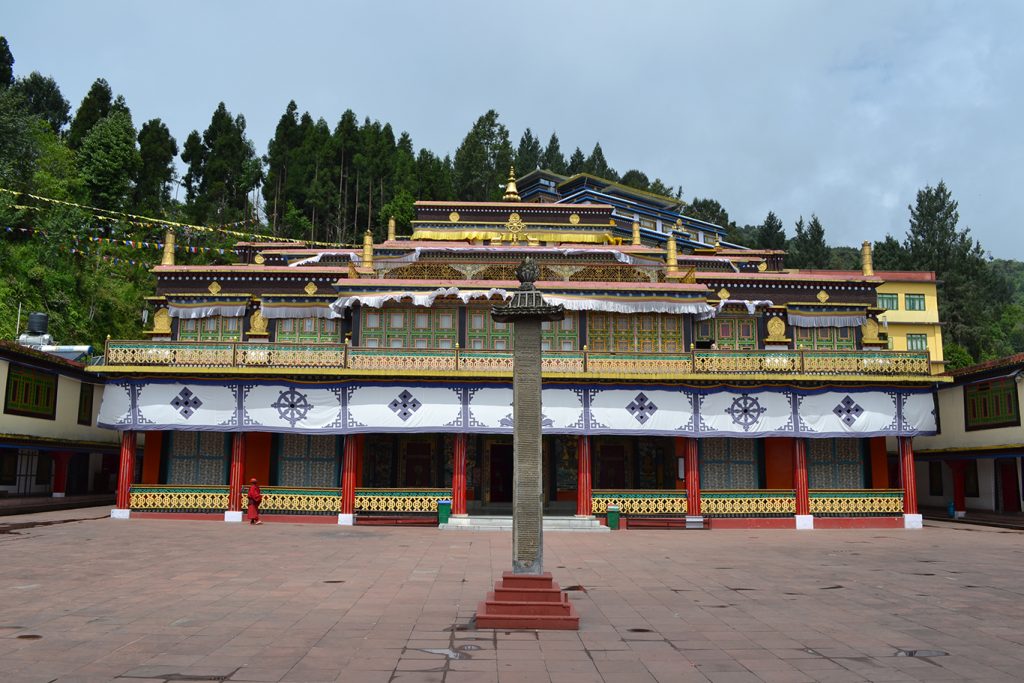
The drive to Rumtek that took us almost an hour from our place of stay at Gangtok, was filled with conversations about Karmapa, the Dalai Lama and the burgeoning faith in the land of Sikkim. Our driver Binay mentioned that Karmapa is very much integral for the success and prosperity of Sikkim. Karmapa is a master or teacher born in the world to propagate Buddha’s teaching. They have an interesting lineage of incarnation. The Karmapa lineage believes that Karmapa gets incarnated in the body to carry out activities. So far there have been 16 Karmapas and the 17th Karmapa Ogyen Trinley Dorje is at present in India. He escaped Tibet in 2000, met the Dalai Lama at Dharamsala, and has been residing there. People in Sikkim hope that he returns to Rumtek, and believe that prosperity follows him.
The Rumtek Monastery was built by the 16th Karmapa Rangjung Rigpe Dorje to propagate the teachings of Buddha. However there was a 17th Century monastery existing here earlier that had been built by the 12th Karmapa Lama-Changchub Dorje. When Rangjung Rigpe fled from Tibet and arrived at this place, he saw only ruins of the ancient monastery. Thus he decided to rebuild the place, and with generous help from the Sikkim king and the locals, he rebuilt the place. The monastery was named as Dharma Chakra Centre, and it contains the sacred relics brought from Tsurphu Monastery, Tibet.
The monastery is a traditional structure, and has a golden sculpture on its rooftop holding a lotus, wheel, bell, a vase, and the jewel ratnasambhava – all Bodhisattva symbols. The entrance has the four guardians of universe depicted, who are responsible for protecting monasteries all over the world. Trudging inside, the main hall has the statue of Buddha, and 1,000 smaller Buddha statues all over it. There are also texts of translation works of Buddhist scriptures displayed, not to mention the colourful thangkas on the walls.
Nearby is the Nalanda Institute and the Golden Stupa. The Nalanda Institute teaches Buddhist doctrines and is affiliated to the Sampurnanand Sanskrit University of U.P, India. Students from all over the world, especially from Nepal and Tibet come to study here. Along with Buddhist philosophy, subjects like Sanskrit and English are also taught here. At the back of this institute lies the Golden Stupa that has relics of the 16th Karmapa. The shrine is pretty, decked up in turquoise and coral. Chants, candles, a picture of Karmapa, create a mystical atmosphere. However, the pack of chips, chocolates and other goodies kept as offerings to the Karma- pa makes you aware of the world outside.
The Tibetology Museum
It is called as the Namgyal Institute of Tibetology after the king of Sikkim, Tashi Namgyal, who donated land towards the institute. The institute was established in 1958, and is a center for Buddhist and Tibetan studies. But what makes this place interesting is the museum on the ground floor. Unique statues, palm leaf manuscripts of the 11th Century, a statue from Tibet of Manjushree – who stands for knowledge – beautiful, embroidered thangkas… a worthy place to visit if you wish a glimpse into Buddhist and Tibet- an faiths and religions.
A couple of minutes’ walk from the institute on an uphill road leads you to Dodrul Chorten Stupa. The stupa is huge and as you go nearer you can see prayer wheels, some 108 in number, surrounding the stupa. The stupa was believed to be built by a lama Trulshig Rinpoche in 1946 to ward off evil spirts residing in this area. You can rotate the wheels – the Tibetan prayers inscribed on them are sure to float in wind and bring peace and prosperity to all. As you go around the stupa you can see another stupa – Jhang Chub Chorten, built in the memory of the Rinpoche after his death.
The Flower Exhibition Centre
Orchids grow wild in this land! No wonder it is the state flower as well. Three hundred varieties of orchids grow in the wild, some in between trees, ferns and mosses. Another 1,200 varieties are grown as well. Sikkim gives a lot of importance to its floriculture. The land of Sikkim, dominated by dense forests, waterfalls, glaciers, has only 10-11 percent available for cultivation. So commercially viable cash crops are given priority.
For a glimpse of these beauties one must head to the Flower Exhibition Centre in Gangtok. In May, apart from orchids there are sunflowers, primulas, bromeliads, ilium, as well.
Temples
Located at 7,200 feet, Hanuman Tok offers splendid views of Kanchenjunga on a clear day. Hanuman Tok is believed to be a brief stopover point of Hanuman, when he went in search of the miracle herb, Sanjeevani, to revive Rama’s brother Lakshmana in Ramayana. After he found the herb in the Himalayas and was flying down to Lanka, he stopped for a moment here. As of now the temple is maintained by the army mountain division.
Eight kilometers from Gangtok lies the Tashi viewpoint that offers a panoramic view of the nearby hills and monasteries. Close to the viewpoint lies the temple of Ganesh, known as Ganesh Tok. It is a small temple on a hill.
The Banjhakri Falls
The name of the Falls is derived from the word Banjhakri. ‘Ban’ means forest or wildness, and ‘jhakri’ means healer, a Shaman deity who has the power to heal anybody possessed by evil spirits. The 100-feet Fall that is located in two acres of land, shows off the Shaman culture. There are images of jhakris, ancestors, and figures of indigenous people of Sikkim – the Lepchas. Gazebos, paved pathways, man-made lakes, foot-bridges and falls create a picturesque landscape, making it an ideal one-hour getaway. The park also utilises renewable sources of energy, and has solar powered lamps and heaters – hence, it is also known as the Energy Park.
Day excursions
The Tsongmo Lake
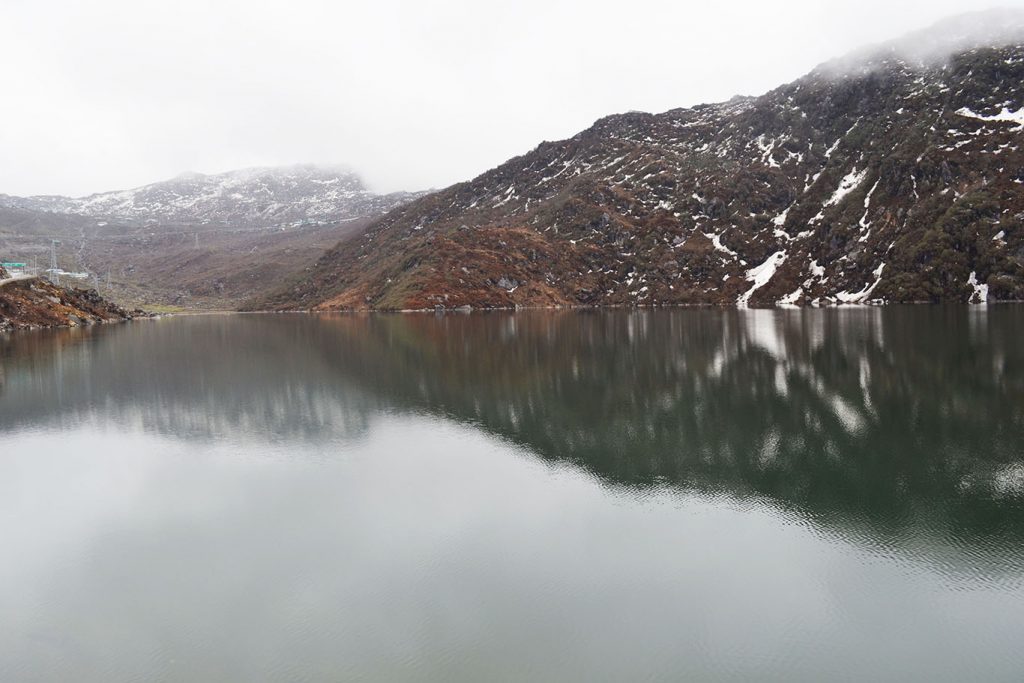
This lake is 40 km from Gangtok on the way to Nathula Pass. As it comes under a restrictive area, permits are required to visit the lake. The lake is situated at an altitude of 12,320 feet. It is an oval shaped, glacial lake, frozen in winters. The colours of the lake change in different seasons. The surrounding peaks are covered with snow during winters, and during summer months, especially during May, the snow gradually melts, adding to the waters of the lake. Flowers like rhododendrons, blue and red poppies sometimes dot the landscape and make a lovely picture. There is a small Shiva temple near the lake as well. It is also a venue for faith healers who assemble here to absorb the healing qualities of the lake.
Joy rides on yaks is allowed here. Yaks survive in harsh terrain and are mighty useful for the locals. The wool of the yak is used to make coats, while its milk is used to make churpi and cheese. The meat is also dried and cooked.
The Baba Harbhajan Shrine
A lot of stories abound about this shrine. Baba Harbhajan was a part of Punjab Regiment of the Indian Army. He died in 1968 from a fall, and it is believed that he appeared in a colleague’s dream asking him to construct a
samadhi/monument in his name. It is believed that the Baba protects Indian soldiers fighting in Nathula Pass and in Sino-Indian border encompassing Sikkim and Tibet. It is also believed that the Baba warns them of an impending attack, days before, giving a fair warning to the army. The site is a popular destination with army men.
Nearby is a 12-feet idol of Shiva. The sitting idol is at a height of 3,000 feet, with the Namnang Chho waterfalls behind the idol. However, to get to the idol, a 10-minute trek uphill is required.
Lachung and Lachen – North Sikkim
Lachen is the base to check out Gurudongmar Lake. At 17,800 feet, it is one of the highest lakes in the world. Lachen is located at 8,838 feet, and is 121 km from Gangtok. It is a six to seven hour journey cutting across Mangan, Chungthang, to reach Lachen. Chungthang is the point where the two streams Lachen Chuu and Lachung Chuu meet. A left from Chungthang takes you to Lachen, and a right, towards Lachung.
Lachen is remote and is a complete surprise. There are not more than 200 houses here. The homes are bare, simple Bhutia styled homes in some cases, with basic amenities. But they are warm. It can get very cold here even in May. So thermals, woolens, play a very important role here.
The Gurudongmar Lake
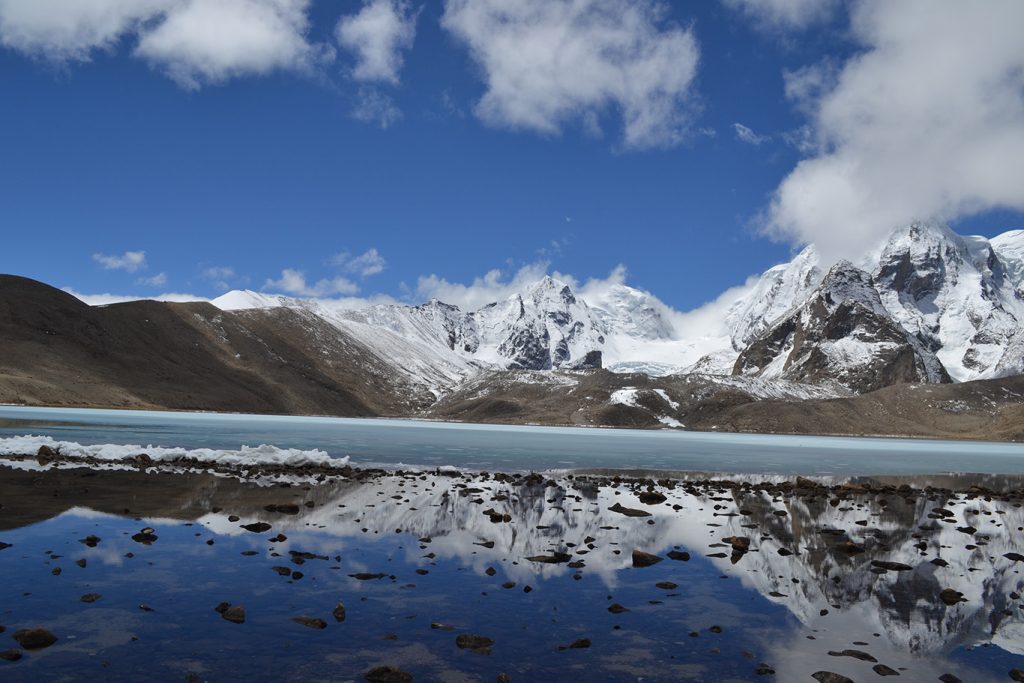
To get to Gurudongmar Lake one has to start early from Lachen, as early as 4 am. En-route, Thangu is the point recommended for breakfast, and the breakfast served is generally Maggi with hot drinks. Our driver Krishna mentioned that the Lepchas move out from Lachen and shift to Thangu during winter.
After Thangu it is a four kilometre drive to the lake. The landscape is astonishing after this. There is barely any vegetation here, the mountains are bare, and you can see the distant snow gleaming. It is an alpine desert, and as you move up, you can see the gleaming glacial lake of Gurudongmar. It is special, and why wouldn’t it be? This lake has been blessed by Guru Rinpoche, and is considered very sacred by the Sikkimese. The Lepchas especially gather around this lake annually. The Lake Tso Lhamo, some five kilometres away from Gurudongmar, is one of the sources of River Teesta as well. And requires special permission to trek.
The Chopta Valley
Another interesting place to visit is the Chopta Valley, i.e., two kilometres from Thangu. The vast valley is filled with flowers in spring, and during winters it is full of snow.
Lachung
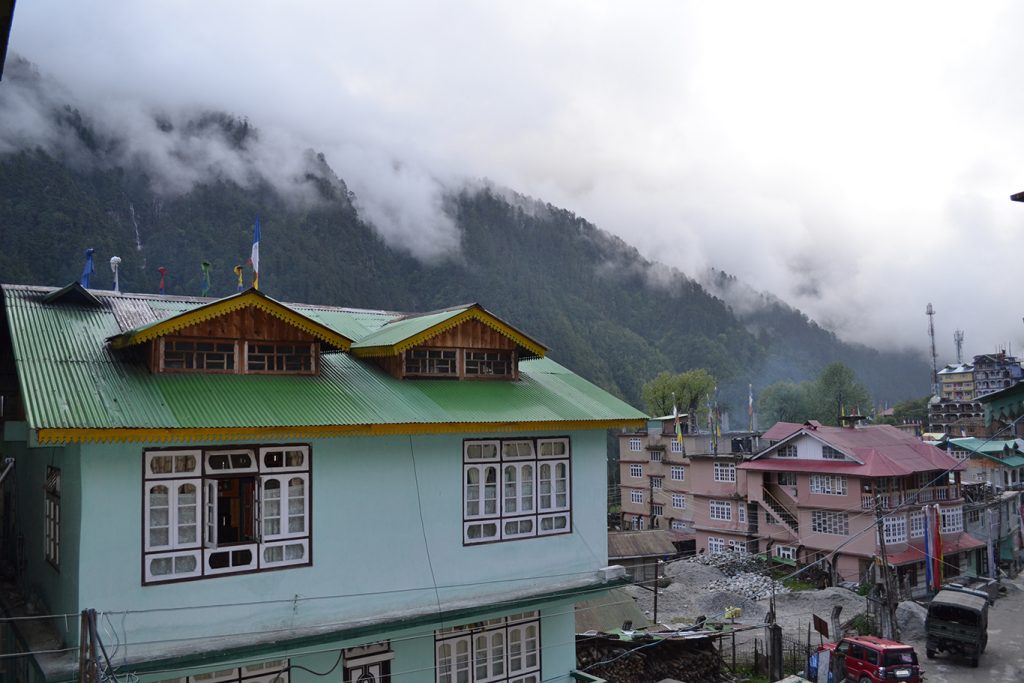
Lachung is 22 kms from Chungthang. Lachung means small pass, and is located at 8,610 feet. It serves as a base point to reach Yumthung and Zero Point. It is a beau- tiful place, less remote, and more commercialised than Lachen.
Yumthung
Yumthung Valley is 25 kms from Lachung, located at a higher altitude of 11,800 feet. The valley is beautiful with River Teesta at her best, flowing through the mountain peaks. The surrounding green landscape, the distant yaks grazing, remind you of a remote English countryside. Yumthung is famous for its hot springs full of sulphur, and is considered medicinal. Also it is popular for rhododendrons. The valley in April-May is full of rhododendrons in various colours such as purple, blue, red and pink.
The Shingba Rhododendron Sanctuary spread over 43 sq kms is full of blooms, especially between March to May. Located eight kilometres from Lachung, the area flowers with different varieties of rhododendrons like Barbatum, Wightii, Glaucophyllum, Lepidotum etc.
The Zero Point

One of the attractions of Sikkim is that it has snow peaks in the month of May as well. The best place to see this is at Zero Point, 23 kms from Yumthung, at an altitude of 15,000 feet. The peaks are full of snow, the icy cold stream running here are a welcome sight. The vegetation, however, is bare, and some distance away is the border across China.
Namchi – South Sikkim
The South district headquarters is Namchi. Namchi has many religious institutions.
Samdruptse Monastery
This monastery is dedicated to Guru Padmasambhava – an 8th Century Buddhist master. It has the statue of Guru Padmasambhava atop a hill, 135 feet high. There is a path to circumambulate the statue. There is a prayer hall too at the monastery with the statue of the Guru.
Chardham
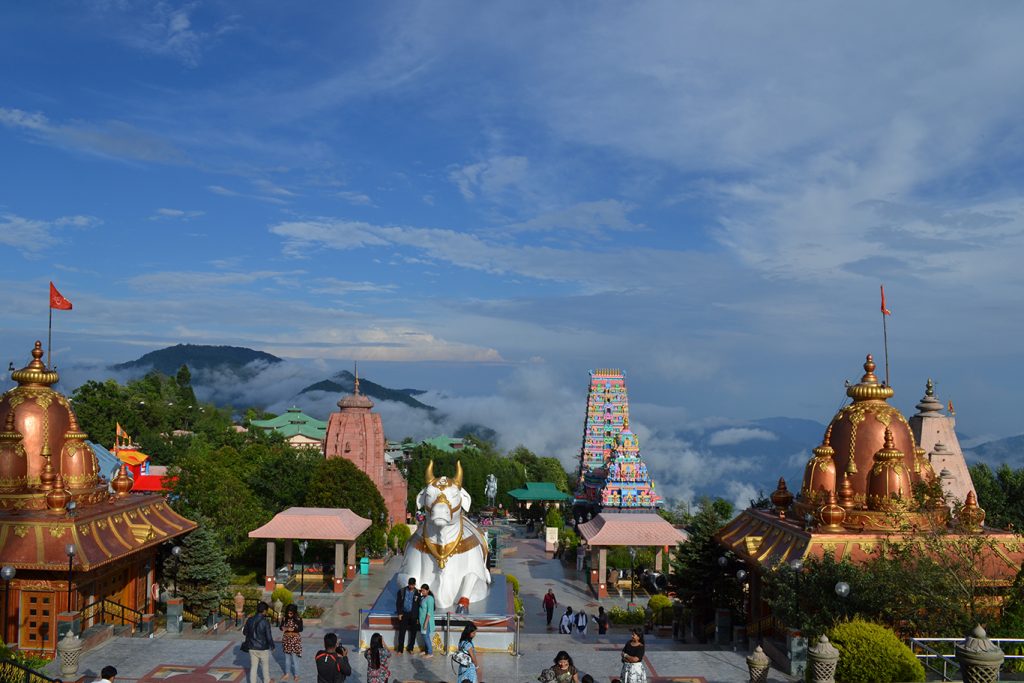
The Chardham as the name suggests, houses the four dhams – Rameshwara, Badrinath, Jaganath and Dwarka. It has the imposing statue of Shiva along with 12 jyotirlingas. On a clear day, the gigantic statue of Shiva and the Guru Padmasambhava on the opposite hill can be seen clearly. Thirty kilometers from Namchi is Ravangla. It has a lovely 23-acre Buddha Park, having one of the tallest statues of Buddha, and is a place worth visiting.
Getting To Sikkim
Gangtok is around 123 kms from Bagdogra, West Bengal. Bagdogra is well connected by flights from cities like Delhi, Kolkata etc. From Bagdogra, you can hire a shared taxi or a private one to get to Gangtok. Helicopter rides are also available from Bagdogra to Gangtok, and it takes a mere 30 minutes to reach the town. If you opt for the train then New Jalpaiguri is the nearest point. From here, either board a taxi or take the public transport to Gangtok from Siliguri. Siliguri is just eight kilometres from New Jalpaiguri.


 [/column]
[/column]